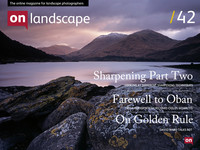More explanation of how to use sharpening

Tim Parkin
Tim Parkin is a British landscape photographer, writer, and editor best known as the co-founder of On Landscape magazine, where he explores the art and practice of photographing the natural world. His work is thoughtful and carefully crafted, often focusing on subtle details and quiet moments in the landscape rather than dramatic vistas. Alongside his photography and writing, he co-founded the Natural Landscape Photography Awards, serves as a judge for other international competitions. Through all these projects, Parkin has become a respected and influential voice in contemporary landscape photography.
In my second article on sharpening I’ll steer away from the theoretical and move onto the practical. Ignoring the ‘magic’ of deconvolution sharpening and the legacy of unsharp masking for a moment, lets have a think about what sharpening can actually do to make an image look sharper.
Well, as you saw from the last article, the sharpening effects look for ‘edges’, either lines or spots/dots, and add a little bit of extra lightness on the light side of the edge and a little bit of extra darkness on the dark side.
The variables between most of the sharpening techniques are as follows

